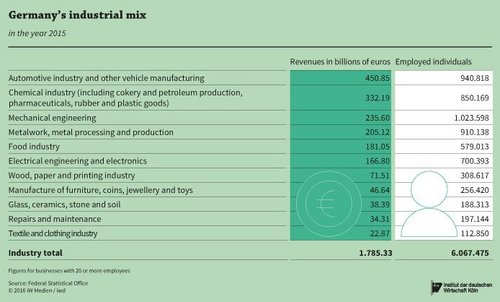While the industrial sector continues to make a substantial contribution to the prosperity and employment market in Germany, it has shrunk considerably in other highly developed countries. The innovative strength of the manufacturing industry in particular can be credited with helping Germany survive the euro crisis.

The industrial sector: A pillar of the German economy
Germany’s manufacturing industry, with its more than 200,000 businesses – ranging from sole proprietorships to large corporations – provides employment for over 7.2 million people. The German industrial sector thus provides as many jobs as the corresponding sector in France, Italy and the Netherlands combined.
If we remove very small businesses and industrial craftsmen from the calculation and only look at companies with 20 or more employees, Germany has 44,300 industrial enterprises with a combined total of nearly 6.1 million employees (see chart).
The manufacturing industry in Germany generates half of its revenues through exports; in 2015, the highest revenues among all industrial segments were generated by vehicle manufacturing, with a total of 451 billion euros.
Germany’s industrial companies and their employees are counted among the winners of globalisation. While the industrial sectors in the USA, Japan, the UK, France and Italy have lost global market shares due to pressure from China, Germany was able to hold its position on the powerfully expanding global market (see table).
The manufacturing industry in Germany generates half of its revenues through exports – with an upward trend.
The industrial sector as a job engine
The industrial segment employing the largest number of people in Germany is that of mechanical engineering, with over 1 million employed in 5,260 companies of 20 employees or more. The vehicle manufacturing segment employs almost just as many people. Of the 940,000 people employed in this segment, 745,000 work in the automotive industry alone (including its suppliers).
Among all industrial segments, vehicle manufacturing generated the highest revenues in the past year, with a total of 451 billion euros.
When combining the metalwork industry with metal production and processing, the resulting segment encompasses 910,000 employees and 7,000 businesses, making it one of the largest three industries in Germany. While metal production primarily takes place in large enterprises, metal processing tends to take place in businesses with medium- or even small-sized structures.
Another industry heavyweight is chemicals and pharmaceuticals, which – combined with plastics manufacturing and upstream petroleum production – employs 850,000 women and men. The electrical engineering and electronics industry follows with 700,000 employees.With 3,300 companies, this industry generated 167 billion euros in revenues in 2015 from electric engines, power plant engineering, control systems and electronics systems.
Germany’s industrial sector is holding its ground
In 2015, the manufacturing industry held a 22.6 per cent share of Germany’s overall gross value added – almost as high as in 1995. During this time, the German industrial sector tackled the challenges posed by the structural change; and in view of its strong mechanical engineering industry and the popularity of German cars, Germany even managed to benefit from China’s rapid economic ascent. “Made in Germany” was, and remains, a strong selling point in China.
SMEs are also benefitting
Not only large corporations but also small- and medium-sized industrial enterprises were able to assert themselves on the global market. The good 1,300 powerful exporting companies played a key role here; depending on the view, these “hidden champions” may be considered larger medium-sized enterprises or smaller large enterprises. In most cases these are family-owned companies with deep roots in their home base, which they remain committed to in spite of globalisation.
When it comes to Germany as a business location, the importance of the industrial sector is evident in the fact that it has the support of so many service providers and craftsmen. Together, they constitute a network of industry and services. Viewed together, the industrial, services and skilled crafts businesses contribute approximately 30 per cent to Germany’s economic output – and this doesn’t even include the construction industry. As a network, the industrial sector boasts a good 10 million employed persons. And when taking into account the multiplier effect of industrial production in other segments, this number increases to between 14 and 15 million employed individuals. After all, when a country’s industrial sector is strong, commerce – among other things – will likewise flourish.
The industrial sector’s importance for Germany can be linked to two additional facts:
Companies in the manufacturing industry made 86 per cent of the private investments in research and development. The average employee in the industrial sector earned approximately 49,400 euros in 2015 – whereas the average income across all sectors was only 32,650 euros (although the proportion of part-time employees is also higher when viewed across all sectors).
More on the topic

Pharmaceutical industry: Increasing pressure on the labor market
The shortage of skilled workers poses significant challenges for pharmaceutical companies in Germany and is expected to become increasingly problematic in the context of demographic changes. Concerning Germany's positioning in the international competition ...
IW
Industrial policy at the turn of the times
The current debate on industrial policy vacillates between the extreme positions of an orthodoxy of rejecting state action and a naive belief in the state's ability to control structural change.
IW